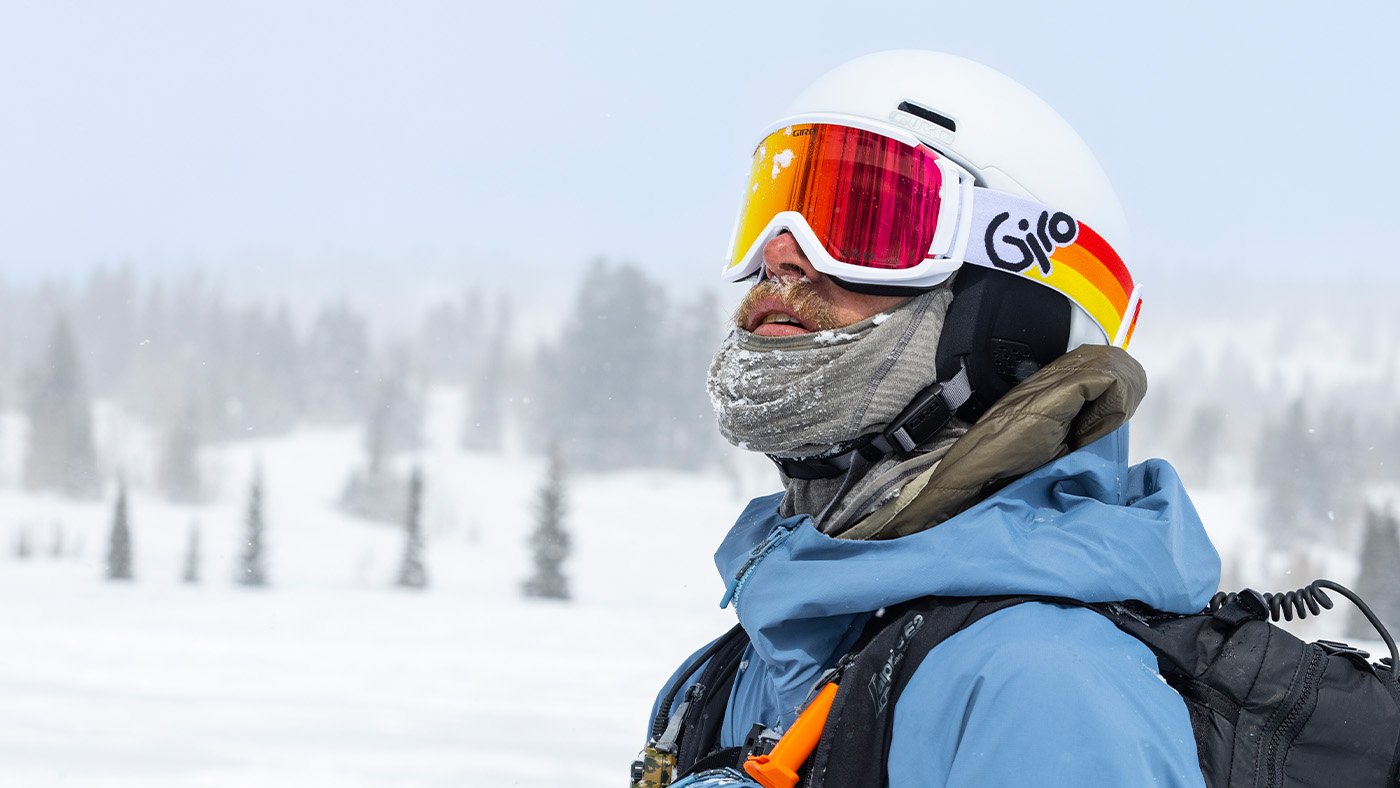Ski/snowboard goggles don’t just make a fashion statement. Goggles serve as an important protective barrier from snow, sleet, and debris from getting into your eyes and inhibiting your vision. Knowing the different goggle technologies, designs, fit, and care can help you make an informed decision on your next goggle purchase.
Location and Time of Year
First, consider your ski location. Location should be considered when selecting ski goggles due to varying weather conditions and light levels. Different terrains and altitudes necessitate specific lens tints and technologies for optimal visibility. Considering the specific conditions of your chosen skiing or snowboarding location ensures the goggles provide the best visual experience and protection.
Why Wear Goggles Rather Than Sunglasses?
There are multiple benefits to wearing goggles instead of sunglasses. Goggles not only have anti-fog and scratch-resistant coatings, but they have foam liners to keep snow, wind, and debris out and promote ventilation. Goggles also provide more face coverage so your face stays warmer and is less exposed to the sun. Giro goggles, specifically, have a seamless helmet integration, this means a better fit and improved function.
Components of Ski/Snowboard Goggles
Simply put, goggles consist of a lens, frame, and strap. Specific features such as the viewport and foam enhance the peripheral view and comfort, respectively.
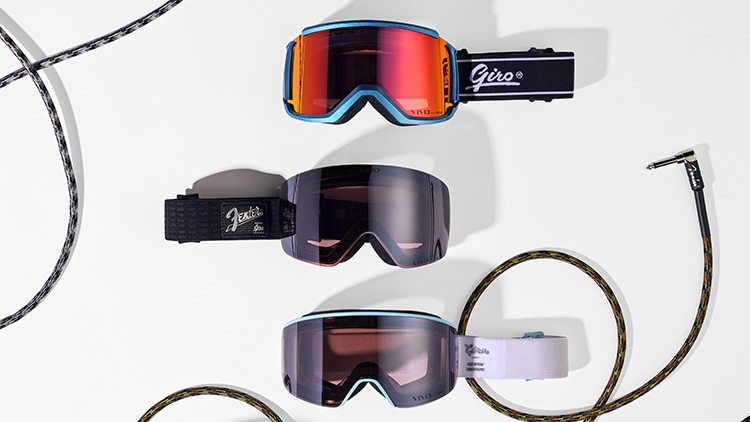
The Lens
Ski goggle lenses come in different shapes, each designed to offer specific optical advantages and unique look. Here are the common lens shapes:
Cylindrical Lens: A cylindrical lens curves left-to-right but are vertically flat – think of it as forming around a cylinder. These flat lenses slightly limit peripheral vision. Lenses like Giro’s Semi, Dylan, and the kid's Chico 2.0 goggles feature injection molded cylindrical lenses. Injection molding a cylindrical lens helps refine optics and minimize distortion that can occur in thermo-formed cylindrical lenses.
Spherical Lens: A spherical lens shape, also known as Toric on Giro goggles, curves both horizontally and vertically – this time think of it as forming around a sphere. These mimic the form of the human eye to provide superior optics. The Contour, Contour RS, and Contact goggles are a few examples that feature a Toric lens.
Viewport
The size and shape of the goggle frame, as well as the curvature and design of the lenses, influence the viewport. A well-designed goggle with an ample viewport is essential for enhancing situational awareness on the slopes, contributing to better performance and safety.
EXV+: EXV+ is Giro's newest version, and it has a special curved lens shape that lets you see more than ever before by giving you an even broader field of view.
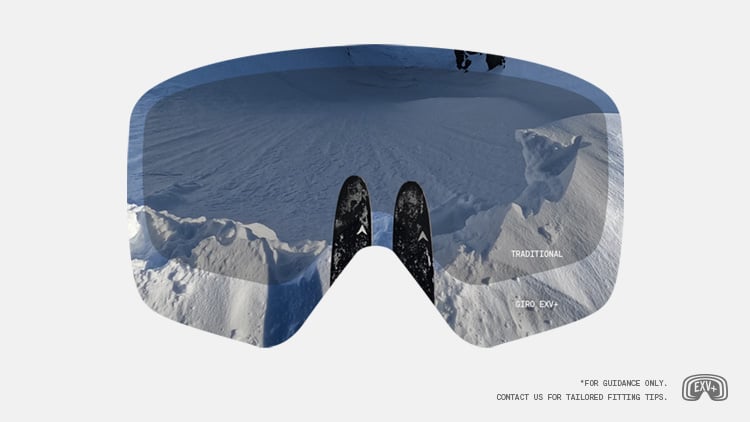
Foam
The foam around the inside of the goggle helps keep snow and debris out and soaks up sweat and/or reduces perspiration.
Single-Layer Foam: Basic face foams are often single-layered and made from a soft, hypoallergenic material. While offering a comfortable fit, they may not provide the same level of moisture-wicking or breathability as more advanced options.
Double-Layer Foam: Goggles with double-layer foam incorporate a softer, moisture-wicking layer next to the skin and a denser outer layer for enhanced durability and insulation. This design helps prevent moisture buildup and improves overall comfort.
Triple-Layer Foam: Triple-layer face foam provides additional comfort. You will also find foam around the goggles’ rim; this is to help prevent fogging and allow circulation through the vents.
Plush Max Fleece: Giro’s Plush Max Fleece facing is a layer (on select goggles) that is a soft contact layer against your face.
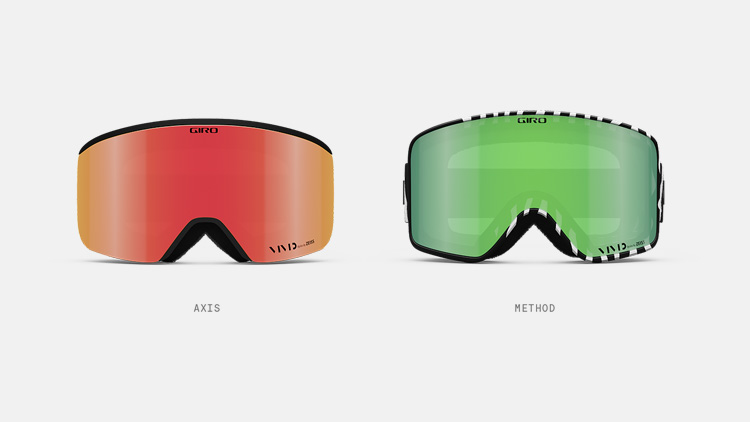
Frame Styles
There are multiple frame styles to choose from: frameless, semi-frame, low-profile frames, and full frames.
Frameless: Frameless goggles have the sleekest design you can find on the market. They provide a maximized field of view and are lightweight.
Semi-Frameless/Low-Profile Frame: Semi-frame goggles like the Axis goggles (above, left) have a partial frame and the Method goggles (above, right) has a low-profile frame.
Full Frames: On full frames you will see the frame wrap completely around the outside of the lens. They offer solid protection and are suitable for various conditions.
OTG (Over-the-Glasses): OTG goggles are designed to have enough room inside the goggles for spectacles and the foam is specifically shaped to fit over the arms of the glasses. Shop for OTG-compatible goggles like Giro’s Index 2.0.
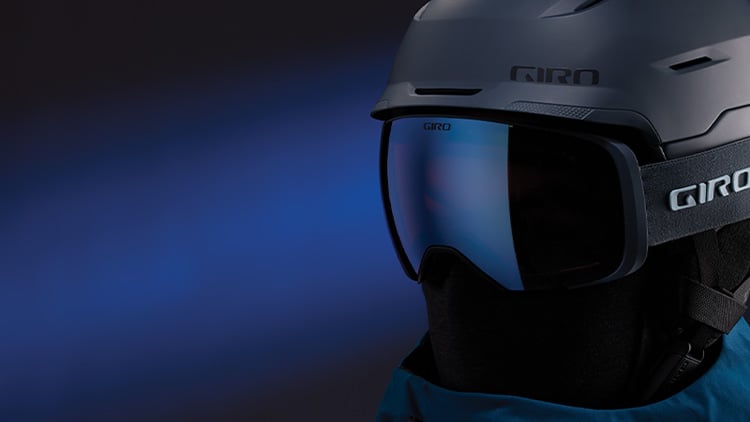
Seamless Integration
Sometimes when you mix and match your goggle and helmet brands you can have gaps between the edge of your helmet and top of your goggles which can lead to skin exposure to the elements. Giro goggles pair perfectly with Giro helmets for seamless integration and excellent coverage.
Strap
The strap stretches to fit comfortably around your head/helmet and has a silicone grip to keep it in place and a traditional slide adjuster to tailor the fit.
Lens Technology
The goggle lenses serve as the core component of ski and snowboard goggles, functioning as a crucial barrier against wind and debris. Beyond merely preserving your vision, lenses can incorporate technologies that actively enhance your visual experience on the slopes. Here are a few you should consider.
Polarized Lens
A polarized lens is designed to reduce glare and enhance clarity by filtering out horizontal light reflections.
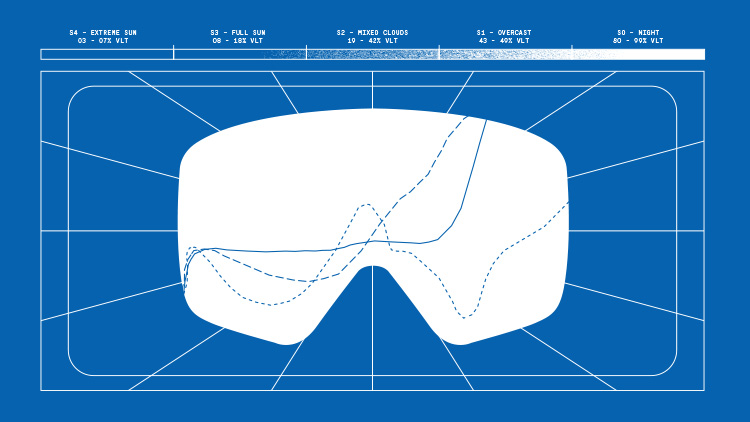
VIVID Lens
While a polarized lens helps reduce glare, Giro’s VIVID lenses go a step further by enhancing contrast and optimizing color filtration, contributing to an improved overall visual experience in diverse lighting scenarios encountered during snow sports. VIVID delivers precise vision without color oversaturation. VIVID Lens Technology effectively manipulates blue light by letting in contrast enhancing blue light, while blocking harmful UV light. VIVID essentially filters out the haze and frees your eyes to spot your line and focus on enjoying your riding experience.
Mirrored Lens
Mirrored lenses in ski and snowboard goggles feature a reflective coating to diminish glare in bright conditions. Available in various colors, they can add a stylish color pop to your look.
Anti-Fog Coating
Fogging and scratches on the lens can limit visibility. To combat both fogging and scratches, look for lenses that feature a durable coating that protect the lens surface.
VLT (Visible Light Transmission)
In short, VLT stands for Visible Light Transmission, and it is the amount of light that makes it through a goggle’s lens. It is measured as a percentage and the lower the VLT percentage, the less light that comes through the lens. The higher the percentage, the more light that comes through. Learn more.
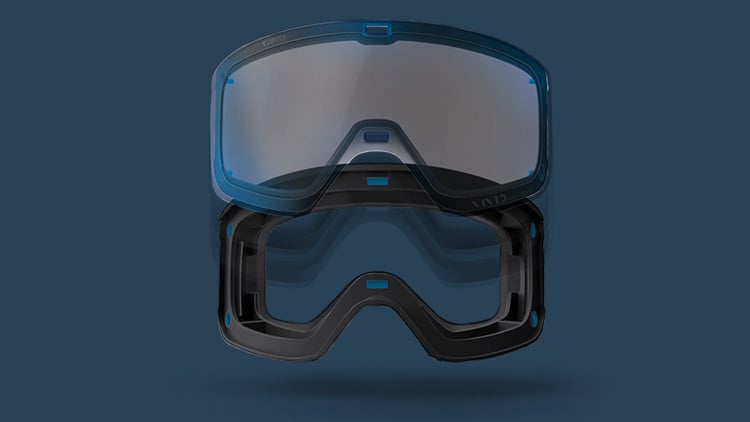
Lens Interchange Systems
Several systems that aid with the interchangeability of lenses in ski goggles, offering users flexibility to adapt to varying light conditions. Here are some common ways and systems for interchangeable lenses:
Magnetic Lens System: Goggles with a magnetic lens interchange system use magnets embedded in the frame and lens. Giro’s Snapshot Lens Interchange System utilizes self-locating magnets and a secure locking mechanism for fast, on-the-fly (or on the chairlift) virtually effortless lens interchange. Upon contact with the frame, the lens snaps into place and then locks down securely. Simply press the shutter button, release the lens, and insert the lens of your choice.
Quick-Change Systems: Many goggles feature a quick-change system that involves a simple and secure mechanism for swapping lenses. Giro’s Quick-Change Lens System uses self-locating magnets to assist in lightning-fast lens replacement and keep the lens securely locked in place.
Snap-In/Snap-Out Systems: Some goggles have a snap-in/snap-out system, where the lens is secured in place with tabs or locking mechanisms. Giro’s Slash Seal is an easy and intuitive interface for swapping out lenses on-the-go. Simply align the lens carrier, new lens, and press the frame and lens together along the perimeter seam to seal the deal.
Ventilation Technology
When choosing ski goggles, considering the ventilation technology is crucial for maintaining clear visibility in various weather conditions. The effectiveness of these technologies can vary, and the choice often depends on personal preferences and the specific demands of the skiing environment.
Dual-Lens Construction
Goggles with a dual-lens design have an outer lens and an inner lens separated by a thin layer of air. This construction minimizes heat transfer, reducing the likelihood of fogging.
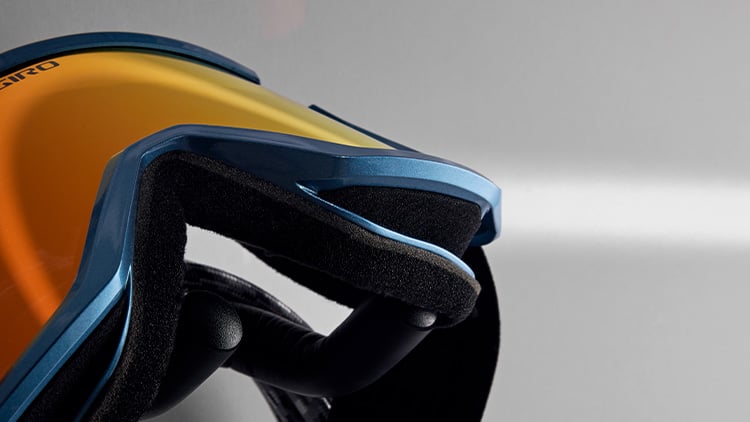
Ventilation Ports or Channels
Goggles often incorporate strategically placed vents or channels that facilitate airflow, promoting effective moisture management. These openings allow air circulation, helping to prevent the buildup of condensation.
EVAK Vent Technology
Giro’s premium goggles feature EVAK Vent Technology which is designed to minimize the chance of fogging with vents that release moisture while simultaneously creating a barrier from the elements. The foam is also made from an ultra-durable, non-absorbent material so you will be comfortable.
Stack Vent
When pairing Giro helmet and goggles together, you can utilize Stack Venting. This innovation stems from research revealing that a significant portion of warm air, leading to fogging, is expelled from the central top vent of the goggles. By aligning the Stack Vent in the helmet with the goggle vent, this design ensures optimal clarity and prevents fogging, enhancing the overall performance of the helmet and goggles.
Goggle Sizes
Ski and snowboard goggles come in various frame sizes to accommodate different face shapes and sizes. While specific sizing can vary between brands and models, goggles are generally categorized into three main sizes:
Small
Designed for smaller faces, including children and individuals with petite facial features. Small goggles offer a snug fit to ensure proper comfort and for smaller wearers.
Medium
This is the most common size and fits. Medium-sized goggles provide a balance between coverage and comfort. They are suitable for a wide range of users with average facial dimensions. Medium to large face shapes should shop for larger frames such as the standard Contour.
Large
Geared towards individuals with larger faces, these goggles offer extended coverage for better peripheral vision and a comfortable fit. Large or extra-large sizes are ideal for those who find standard goggles too constricting.
RS (Reduced Size)
Giro offers goggles sized specifically for women and children. Giro's Contour RS is a goggle designed specifically for smaller faces, there’s a version for women and men. There are also youth-specific goggles such as the Buster and Chico 2.0.
Fit and Care
In order to get the most out of your goggles you'll want to make sure it fits correctly and is well taken care of. An improper fit can result in the goggle shifting around on your face and/or be prone to fogging. Simply wiping the lens down with your sleeve can result in permanent lens damage. Take a look at these tips on proper fitment and care.
How to Fit Your Goggle
A proper fit is crucial when it comes to goggles. Make sure your goggles form a tight seal on your face and use the adjustable strap to adjust the fit around your head or helmet.
How to Clean Your Goggle
Regular cleaning ensures clear vision, safety, and prolonged goggle performance on the slopes. To clean your goggle lens do not use any paper products, including Kleenex® or a similar tissue. To clean the outside of the goggle lens you can breathe on the lens to create moisture vapor and gently blot or dab the outside lens with a soft microfiber cloth. If you need to clean the inside of your lens gently dab the lens rather than wiping it, which can remove the anti-fog coating or create scratches that permanently damage the lens.
How to Store Your Goggles
Proper ski goggle storage safeguards lenses, frames, and straps, ensuring longevity, hygiene, and optimal performance on the slopes. Store goggles in a dry, warm, well-ventilated area so they are sufficiently dried out after each use. Putting them in a goggle bag or dedicated goggle box will help protect them from damage.
